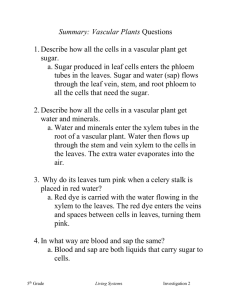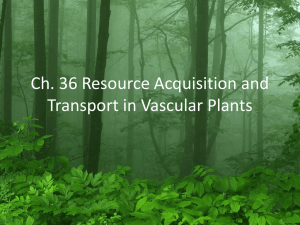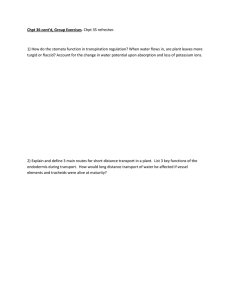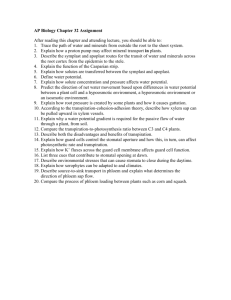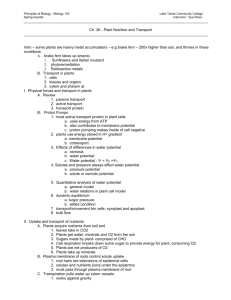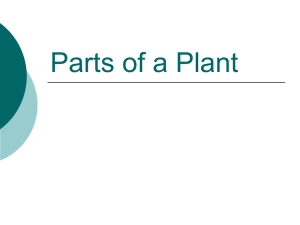Lecture #16 Date ______ Chapter 36~ Transport in Plants
advertisement
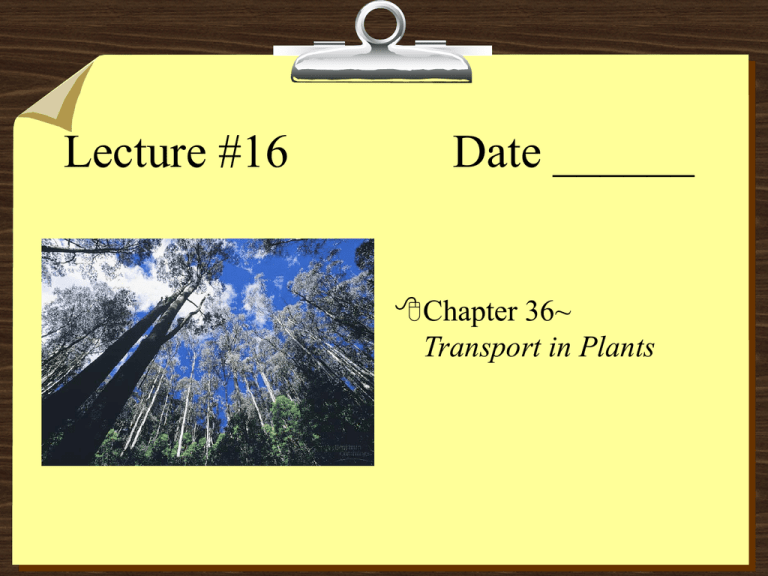
Lecture #16 Date ______ Chapter 36~ Transport in Plants Transport Overview 1- uptake and loss of water and solutes by individual cells (root cells) 2- short-distance transport from cell to cell (sugar loading from leaves to phloem) 3- long-distance transport of sap within xylem and phloem in whole plant Whole Plant Transport 1- Roots absorb water and dissolved minerals from soil 2- Water and minerals are transported upward from roots to shoots as xylem sap 3- Transpiration, the loss of water from leaves, creates a force that pulls xylem sap upwards 4- Leaves exchange CO2 and O2 through stomata 5- Sugar is produced by photosynthesis in leaves 6- Sugar is transported as phloem sap to roots and other parts of plant 7- Roots exchange gases with air spaces of soil (supports cellular respiration in roots) Cellular Transport Water transport √ Osmosis; hyper-; hypo-; iso Cell wall creates physical pressure: √water potential solutes decrease; pressure increase Water moves from high to low water potential Flaccid (limp, iostonic); Plasmolysis (cell loses water in a hypertonic environment; plasma membrane pulls away); Turgor pressure (influx of water due to osmosis; hypotonic environment) Transport within tissues/organs Tonoplast vacuole membrane Plasmodesmata (components) cytosolic connection Symplast route (lateral) cytoplasmic continuum Apoplast route (lateral) continuum of cell walls Bulk flow (long distance) movement of a fluid by pressure (xylem) Transport of Xylem Sap Transpiration: loss of water vapor from leaves pulls water from roots (transpirational pull); cohesion and adhesion of water Root pressure: at night (low transpiration), roots cells continue to pump minerals into xylem; this generates pressure, pushing sap upwards; guttation Cohesion of Water QuickTime™ and a Cinepak decompressor are needed to see this picture. Transpirational Control Photosynthesis-Transpiration compromise…. Guard cells control the size of the stomata Xerophytes (plants adapted to arid environments)~ thick cuticle; small spines for leaves Translocation of Phloem Sap Translocation: food/phloem transport Sugar source: sugar production organ (mature leaves) Sugar sink: sugar storage organ (growing roots, tips, stems, fruit) 1- loading of sugar into sieve tube at source reduces water potential inside; this causes tube to take up water from surroundings by osmosis 2- this absorption of water generates pressure that forces sap to flow alon tube 3- pressure gradient in tube is reinforced by unloading of sugar and consequent loss of water from tube at the sink 4- xylem then recycles water from sink to source
